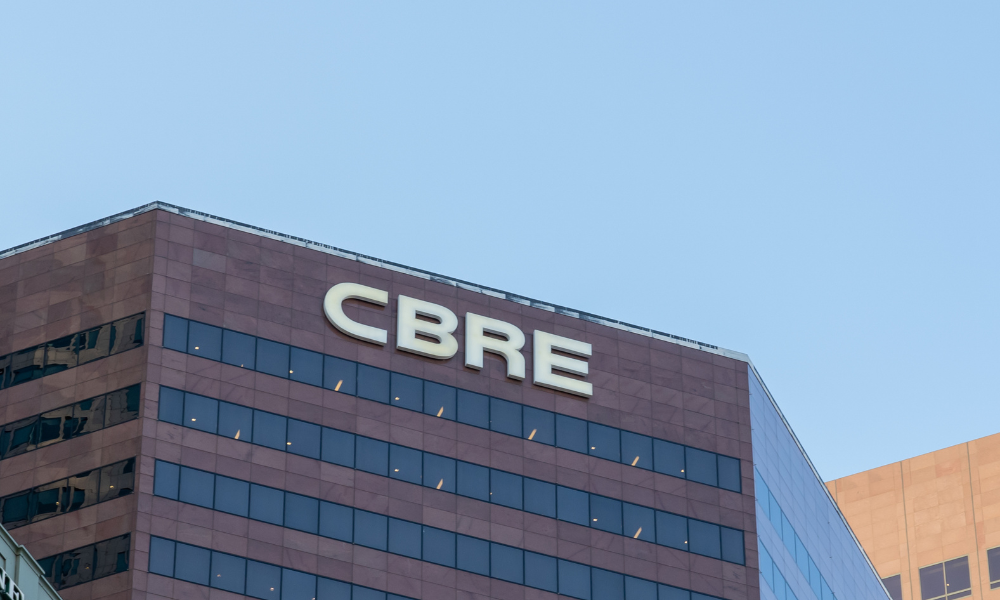

The commercial real estate sector got a boost Thursday when CBRE Group Inc. reported strong fourth-quarter earnings and suggested the worst was over for the downtrodden market for office leasing.
Shares of the world’s largest commercial real estate stock jumped to the highest level in almost two years, while all but one of the 31 members in the S&P 500 Real Estate Index closed the day in the green. Smaller peers including Cushman & Wakefield Plc and Jones Lang LaSalle Inc. both gained more than 8%.
“We are cautiously optimistic that the worst is over for office leasing, particularly for Class A properties where we generate approximately two-thirds of our leasing revenue,” CBRE said in a call with analysts Thursday morning.
That optimistic tone could help quell worries about the market for commercial real estate that have roiled shares in property managers and lenders from New York to Munich and Japan in recent weeks. New York Community Bancorp shares characterized the turmoil after plunging last week when it reported a surprise loss, prompting regulators and Treasury Secretary Janet Yellen to caution about exposure to the sector.
Office occupancy in major cities around the world has been slow to recover in many instances, leaving property managers and their lenders potentially exposed to losses. CBRE executives said that the worst of that has passed.
“We think it is bottomed out,” said Robert Sulentic, chief executive officer. “There’s just a clear amount of pressure from companies to get their people back into the office. You’re going to see the future be better than the current circumstances have been for a variety of reasons.”
Shares of NYCB rose 6.3%, while a measure of regional bank stocks added 3.6%, the biggest one-day gain since mid-December. The group had been under pressure since NYCB’s surprise loss and as investors scoured balance sheets for exposure to potentially loss-making property loans.
CBRE reported adjusted earnings per share of $1.38, topping the average analyst estimate of $1.18, according to data compiled by Bloomberg. Revenue in the quarter rose more than 9% to about $9 billion, beating expectations for $8.47 billion.
But it was CBRE’s annual profit forecast that helped ease some concerns about the state of the market. For 2024, the firm said it expects to achieve core earnings-per-share of $4.25 to $4.65, implying growth that is above 10%.
That guide may even be on the conservative side, according to JP Morgan analysts led by Anthony Paolone.
“Our read from comments on this front is that it is baking in conservatism and giving itself a decent amount of room in the bottom-line numbers if the backdrop changes and negatively impacts the top line,” Paolone wrote in a note. “That’s positive, in our view, and we’d also argue it suggests the business is trending better than feared for all the names in the space at the moment.”
Stephen Sheldon of William Blair also said that there are clear secular growth drivers supporting larger commercial real estate service firms with CBRE leading the industry.
“We believe there could be a multiple re-rating for the CRE group across the cyclical spectrum (early cycle, mid-cycle, and late cycle) that could support returns for CBRE shareholders over the medium term,” Sheldon wrote in a note.

President meets with ‘highly overrated globalist’ at the White House.

A new proposal could end the ban on promoting client reviews in states like California and Connecticut, giving state-registered advisors a level playing field with their SEC-registered peers.

Morningstar research data show improved retirement trajectories for self-directors and allocators placed in managed accounts.

Some in the industry say that more UBS financial advisors this year will be heading for the exits.

The Wall Street giant has blasted data middlemen as digital freeloaders, but tech firms and consumer advocates are pushing back.
Orion's Tom Wilson on delivering coordinated, high-touch service in a world where returns alone no longer set you apart.
Barely a decade old, registered index-linked annuities have quickly surged in popularity, thanks to their unique blend of protection and growth potential—an appealing option for investors looking to chart a steadier course through today's choppy market waters, says Myles Lambert, Brighthouse Financial.
